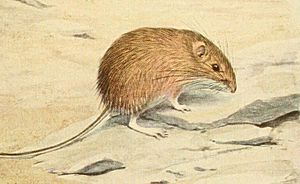Hispid pocket mouse facts for kids
Quick facts for kids Hispid pocket mouse |
|
|---|---|
 |
|
| Conservation status | |
| Scientific classification | |
| Genus: |
Chaetodipus
|
| Species: |
hispidus
|
The hispid pocket mouse (Chaetodipus hispidus) is a type of pocket mouse found in the Great Plains area of North America. It's known for its bristly fur, which is why it's called "hispid" – that word means "bristly"! These mice are part of a group called Chaetodipus.
Where They Live
The hispid pocket mouse lives across the Great Plains region. You can find them from southern North Dakota all the way down to central Mexico. They live west of the Missouri River up to the Rocky Mountains. However, they don't live in the far eastern parts of Kansas or Missouri.
What They Look Like
This mouse is one of the biggest pocket mice around. Its fur is bristly, just like its name suggests! The fur is yellowish with black hairs mixed in on its back. It has a clear, buffy (light yellowish-brown) line along its sides. Its belly is white.
| Size of an Adult Hispid Pocket Mouse | |
|---|---|
| Length | 190–237 mm |
| Tail | 90–115 mm |
| Hind foot | 23–30 mm |
| Ear | 12–14 mm |
| Weight | 35–60 g |
Behavior and Habitat
Hispid pocket mice live in many different upland (higher ground) areas. They are most common where the soil is sandy and there are patches of bare ground. You can also find them in places with rocky or loamy (rich, fertile) soil. These mice avoid rocky prairie and seem to stay away from sand dunes and areas near rivers (called riparian zones).
They prefer areas with a mix of short to medium-height grasses, shrubs, forbs (flowering plants that are not grasses), cacti, and/or yucca plants.
Hispid pocket mice mostly eat seeds. They are very picky about the seeds they gather. However, they also eat some insects and leaves.
They always dig their burrows in soft soil. Their burrows usually have two or three entrances, which they often plug up. Unlike other pocket mice, the hispid pocket mouse often leaves a noticeable mound of earth outside its burrow entrance. These mounds are smaller than those made by pocket gophers.
Hispid pocket mice are solitary, meaning they live alone.
Reproduction
Scientists don't know a lot about how these mice reproduce. Adult males have been found with larger testes (a sign of being ready to breed) from March through October. Pregnant females have been caught in July and August. Because their breeding season lasts so long, it's thought that females can have two or more litters of babies each year.


